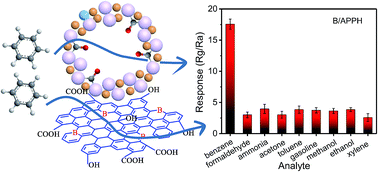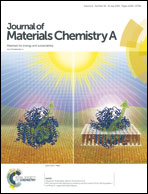Boron-doped graphene quantum dot/Ag–LaFeO3 p–p heterojunctions for sensitive and selective benzene detection
Abstract
Carrier-transport is important in the field of metal oxide semiconductor gas sensors because it directly determines the sensor response and operating temperature. In this paper, gas sensors for monitoring of benzene are developed based on a boron-doped graphene quantum dot (BGQD)/Ag–LaFeO3 p–p heterojunction (B/APPH). The band gap of the BGQDs and Ag–LaFeO3 matched well, promoting separation of electron–hole pairs and enhancing the carrier transport ability. The introduced Ag catalytically oxidized benzene into CO2 and H2O in gas-sensing reactions. We optimized the selectivity of the B/APPH by benzene molecular imprinting. Our results show that B/APPH possesses a high response (17.5) and good selectivity, repeatability, and accuracy at a low operating temperature (65 °C) for detection of as little as 1 ppm of benzene. The heterojunction between the BGQDs and Ag–LaFeO3 improved the carrier-transport ability and reduced the operating temperature while maintaining the high sensing response and selectivity. The ability to modulate carrier-transport developed in this work will guide work on high performance gas sensors based on metal oxide semiconductors.



 Please wait while we load your content...
Please wait while we load your content...